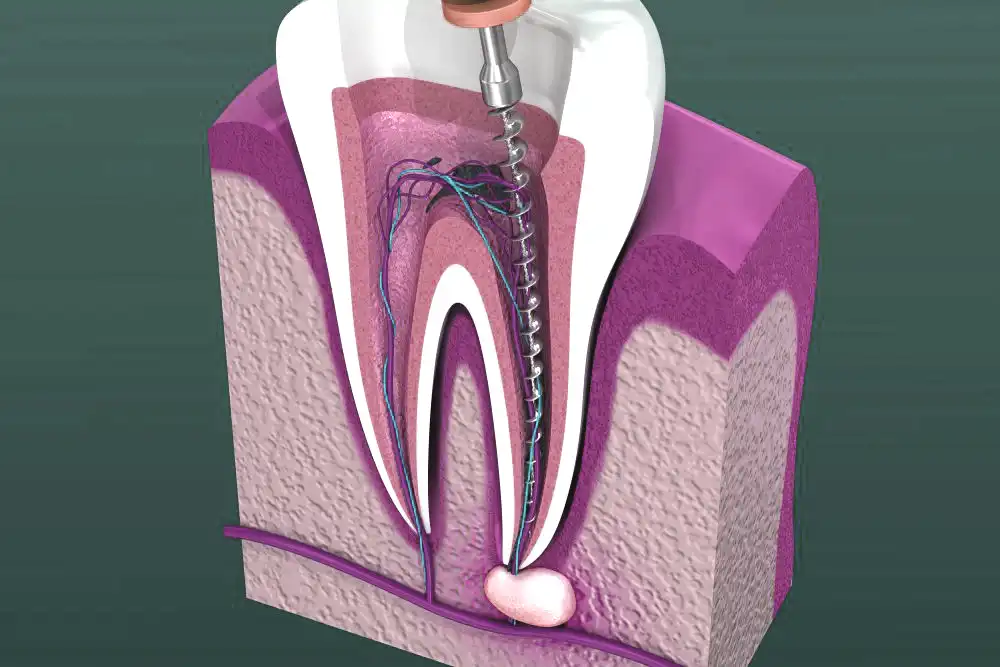When you hear the phrase “root canal,” you might feel a twinge of anxiety. However, understanding what a root canal involves can ease your concerns and help you appreciate why this treatment is sometimes necessary.
Root canals are a common dental procedure used to treat infection at the center of a tooth. This guide will explain the causes, symptoms, and what you can expect before, during, and after the procedure, along with the role of dental crowns in protecting your teeth.
What Causes a Root Canal?
A root canal becomes necessary when the pulp inside your tooth becomes inflamed or infected. This could be due to several reasons:
- Deep Decay: When a cavity has penetrated deep into the tooth, reaching the pulp.
- Repeated Dental Procedures: Multiple procedures on the same tooth can cause stress and damage.
- Cracks or Chips: Damage to the tooth can expose the pulp to bacteria.
- Injury: Even if a tooth injury doesn’t cause visible damage, it can still harm the pulp.
Why Do You Need a Root Canal?
The main reason for a root canal is to save a tooth that would otherwise need to be extracted. Preserving your natural teeth is vital because they function better than artificial teeth.
Root Canal Symptoms
Symptoms indicating you might need a root canal include:
- Severe tooth pain when eating or applying pressure
- Prolonged sensitivity to hot or cold temperatures
- Swelling and tenderness in nearby gums
- Darkening of the tooth
What Happens During a Root Canal?
Understanding the step-by-step process of a root canal can help demystify the procedure:
Endodontic Treatment Step by Step
- X-ray: The dentist takes X-rays to see the shape of the root canals and determine if there’s an infection in the surrounding bone.
- Anesthesia: Local anesthesia is applied to numb the tooth and surrounding area.
- Pulpectomy: The dentist makes an opening in the tooth and removes the diseased pulp.
- Cleaning and Shaping: The root canals are cleaned, shaped, and disinfected.
- Filling: The empty canals are filled with a rubber-like material called gutta-percha. The opening is then sealed with a temporary filling.
What Does a Root Canal Feel Like?
Due to anesthesia, the procedure itself is relatively painless, though you may feel some pressure during the process. Post-procedure, you might experience some discomfort, which can be managed with over-the-counter pain relievers.
What Happens After a Root Canal?
After the root canal, it’s essential to care for the treated tooth properly. Here’s what you need to know:
Tooth After Root Canal
- The tooth may feel sensitive for a few days due to tissue inflammation, especially if there was pain or infection before the procedure.
- Follow your dentist’s instructions regarding eating and oral hygiene.
Why Are Dental Crowns Necessary?
A dental crown is often required after a root canal to:
- Protect the Tooth: A tooth that has undergone a root canal is weaker and more prone to fracture.
- Restore Function: Crowns help restore your tooth’s function and appearance.
- Prevent Re-Infection: A crown seals the tooth, preventing bacteria from entering.
Choosing the Right Dental Professional
When considering a root canal or dental crown, selecting a qualified professional is crucial. Consider choosing a reputable endodontist like Brian L. Porter, who can provide expert care and guidance.
Dealing with Root Canal Complications
Although root canals have a high success rate, complications can occur.
Root Canal Infection
Signs of a root canal infection include:
- Persistent pain
- Swelling
- Fever
If you notice these symptoms, contact your dentist promptly. Infected root canal removal or retreatment might be necessary.
When Root Canal Therapy Fails
Occasionally, a tooth may not heal properly after a root canal. Causes include:
- Complex canal anatomy that was not detected during the initial treatment.
- A breakdown of the inner sealing material over time.
- Contamination of the inside of the tooth due to saliva entering the area.
Alternatives to Root Canals
In some cases, a root canal may not be the best option. Alternatives include:
- Extraction: Removing the tooth and replacing it with an implant or bridge.
- Pulp Capping: A treatment used for teeth with only minor pulp exposure.
Choose Brian L. Porter, DDS
Understanding root canals and dental crowns can alleviate fear and help you make informed decisions about your dental health. This procedure not only saves your tooth but also maintains your smile’s integrity.
If you’re experiencing any symptoms or have concerns about your dental health, consult with a dental professional to explore your options and get the care you need. Remember, preserving your natural teeth is always the goal, and a root canal can be a vital part of that process.
1109 E. James Ave.
Baytown, TX 77520
281-422-3415
View our Google Business Listing

